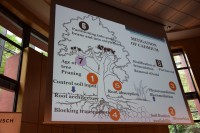Runder Tisch Kakao
Committed to flavour
Hamburg was recently the epicentre of cocoa trade and research. Approximately 180 participants gathered here for the “Cocoa Round Table” conference in order to exchange information about cultivation, fermentation and quality. The lectures and posters dealt with the motto “Where does the path lead? Perspectives through 2020”.
By Dr Jörg Häseler
The organizer, Prof. emeritus Reinhard Lieberei, the “Cocoa Round Table” founder, Prof. Sascha Rohn (University of Hamburg) and Dr Daniel Kadow (August Storck KG) once again compiled an informative programme concerning the resource raw cocoa. The content emphasized during the seminar, which was supported by the Stiftung der Deutschen Kakao- und Schokoladenwirtschaft [German Cocoa and Chocolate Trade Foundation], included raw cocoa quality, cocoa fermentation, contaminants, and cultivation systems.
The topic of cocoa fermentation kicked off the event, dealing with the control and development of specific sensory qualities. Prof. Jörg Stender (from the Hochschule Ostwestfalen-Lippe school) shared his findings about cocoa fermentation research on a laboratory scale. Over the course of an application-oriented series of research, he came to the determination that various cell cultures have significant influence on the sensory quality of chocolate made from these cocoa beans. Further, he postulated that the flavour formation process can be controlled with a great level of certainty through the addition of defined microflora, thereby enabling the desired flavour formation to be achieved.
Prof. Nikolai Kuhnert (Jacobs University Bremen) gave the comparative chemical analysis of raw and fermented cocoa beans. The results of this analysis have the potential to be used in areas like food fraud as well. 12,000 signals for substance of contents can be detected in fermented cocoa, and a whopping 35,000 for roasted cocoa. Amongst the fats, these substances include 50 triacylglycerides. Beyond those, 23 carbohydrates, 100 phenols, and around 400 peptides have been verified. The latter are the precursors for the cha-racteristic cocoa flavour.
Prof. Thomas Hofmann (TU Munich) showed the journey from chemosensory codes to comprehensive flavour quantification in food. At over 12,000, the number of known flavouring agents is impressive. However, ultimately a toolkit with around 230 ephemeral compounds is sufficient to create our food in the laboratory. For example, 28 key odorants yield red wine, and around 30 suffice for most other foods.
Focus on cultivation and sustainability
A solution for the challenge of differentiating fine and standard cocoa was reserved for trained noses. Over the course of molecular-sensory characterisation of the flavours of Nacional cocoa and CCN-51, Dr Martin Steinhaus (Deutsche Forschungsanstalt für Lebensmittelchemie) [German Research Institute for Food Chemistry] discovered that 2-phenylethanol and ethyl (phenylacetate) as well as (2-phenylethyl)acetate, phenylacetic acids, and phenylacetaldehyde contribute to the characteristic floral flavour of Nacional cocoa. Quantification of 2-phenylethanol, linalool, and phenylacetaldehyde after water treatment can contribute to differentiation between Nacional cocoa and CCN-51.
The cocoa fruit ought not to be reduced solely to the supply of the beans. For this reason, there were various submissions on the topic of sustainability. For example, projects were introduced to use the pulp as a base for tasty beverages and jams reminiscent of lychee. Similarly, substances from cocoa shells can yield materials, making it possible to produce everything from the cocoa fruit: praline contents, chocolate coatings, and packaging.
In her lecture on “Agricultural forest versus monoculture – strengths and weaknesses of cultivation systems,” Monika Schneider of FiBL (Forschungsinstitut für biologischen Landbau [Research Institute for Organic Cultivation], Frick/Switzerland) presented the central criteria for planting systems of the future. Conventional farming of cocoa trees in monoculture leads to more frequent instances of disease and pests. Further, soil becomes less fertile over time, leaving farmers to struggle with successively sinking yields. FiBL compared crop yield security and economic feasibility of agricultural forest systems with conventional monoculture farming in Sara Ana/Bolivia. Partners included Ecotop, the Institute for Ecology at the UMSA University in La Paz, as well as Piaf-El Ceibo.
The agricultural forest system is based on natural planting succession and encompasses annual cultures as well as various fruit and forest trees. The system is especially well-suited for smaller family operations, who can utilise the resulting by-products like bananas, cassava roots and firewood for self-sufficiency, although it should be determined beforehand whether there is demand for the by-products.
Particular attention was paid to the lecture from Prof. Pathmanathan Umaharan (Cocoa Research Center Trinidad/Tobago), who dealt intensively with the reduction of bioaccumulation of cadmium in cocoa plants. The topic of cadmium is a high priority in the industry, as the following limits apply starting in 2019: milk chocolate with less than 30 % cocoa may contain a maximum of 0.1 mg of cadmium/kg. 0.3 mg/kg applies for chocolate with 30 to 50 % cocoa, and 0.8 mg/kg is the highest limit for chocolate with at least 50 % cocoa. The limit for cocoa powder is 0.6 mg/kg.
Mould may cause musty flavour in chocolate
Transitional deadlines are planned and should give producers time to implement the new limits – a difficult undertaking for cocoa farmers whose plantations have high cadmium levels in the soil. An effective means is to apply lime to the plantation soils, as it increases the pH of the soil, thereby drastically reducing the absorption of cadmium.
Amongst the avoidance strategies to reduce cadmium entry are assessing the soil, determining the soil’s fixation potential, restoration through other biological systems, and blocking the transporter systems in the soil. In addition, there is the prevention of absorption through the roots, observing the effect of tree age at pruning, and the separation of fruit flesh, beans, and seed leaves. Further, mo-dification of fermentation after harvest and/or removing the seed coat is recommended.
Time and again one reads and hears about geosmin as a cause of poor flavour in chocolate. This can be verified and quantified analytically through an established method. It would be interesting, however, to learn how this forms, especially if a poster presentation could deliver a solution, as this earthy-musty smelling substance is formed by mould, amongst other things.
The 8th “Cocoa Round Table” will take place in June 2019. One year prior – from 22 to 25 April 2018 – the international chocolate world will meet in Berlin for the 4th World Cocoa Conference.•




